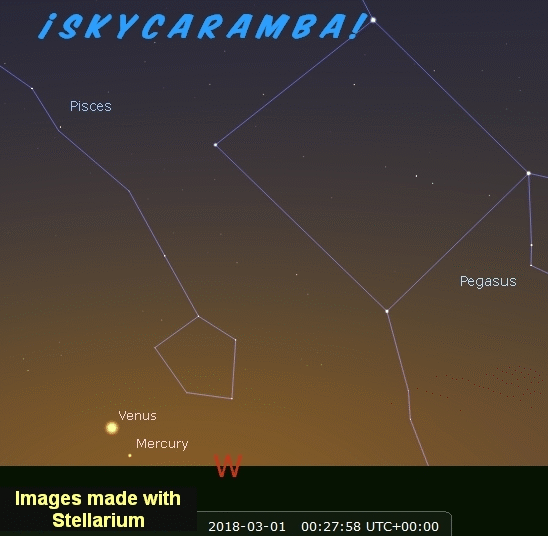March is the second month this year with two full moons. The moon is almost full as the month begins. As it rises in the east just after sunset, be sure to turn around and see Venus and Mercury together setting in the west. They are below the eastern fish of Pisces which you’ll find left of the Great Square of Pegasus.
It will be a few hours before you get to see any more planets. Watch Leo, Virgo, and Boötes rise. Then around local midnight, Libra comes up with Jupiter in the eastern part of the diamond. Mars rises a few hours after midnight. Don’t mistake the red planet for its stellar rival Antares. The star is about 11 degrees right of the planet. A little while later, Saturn joins our sky with the “teapot” that is Sagittarius close below it.
These morning risers are somewhat southerly in their range because they’re near the more southerly part of the ecliptic. So to someone watching them from the northern hemisphere, they’ll rise in the southeast.
Look up toward Lyra in the hour or two before sunrise. Below left is Cygnus the swan. Another celestial bird, Aquila the eagle, is below right. Our morning sky zoo is also home to Vulpecula, Delphinus, and Equuleus. They are the little fox, dolphin, and little horse, respectively. In their midst is Sagitta, an arrow, but there is another animal to be found north of them past Cygnus. Lacerta is a lizard.
Viewers far enough north may notice that even though it is still setting in the west after sunset, the bigger and winged horse Pegasus is already rising in the morning before sunset. It doesn’t spend as much time below the horizon as the sun does this time of year for the same reason the sun spends less time below the horizon during northern summers. The earth’s axial tilt puts northern objects above the horizon for more of any given 24 hour period. But Pegasus stays a northern constellation. The sun is a southern object for part of the year and a northern object the rest. The change, as the sun crosses the equator, is coming this month.

Watch Mercury pass close to Venus on the 4th and then go above the planet for about two weeks. Venus is also heading upward into our evening sky and will outpace the messenger planet. By the 22nd, Venus is clearly passing Mercury. And by the end of this month, Mercury is retreating far enough into the glow of sunset as to be vanishing from our evening sky. But keep watching Venus. Our easy-to-see beauty of the evening sky is about to brush by another planet so dim it went undiscovered until 1848 even though it can be seen with the naked eye. Venus will be 4’ or 0.7° south of Uranus on the 29th. Point a telescope at Venus to see Uranus. You may need to wait until it’s dark enough to see both which means they won’t be far above the horizon, so make sure your horizon’s clear too.
Although it looks like it’s about to, Jupiter does not leave the diamond of Libra this month. It goes retrograde just one week into March and heads back toward the middle of the constellation. It actually will exit the diamond in June, but on the other side! If you want to see Jupiter leave on the side near Zuben Elakrab, keep watching it all the way into October.
Mars heads toward Sagittarius for a close call with Saturn. The two will appear closest in early April.
